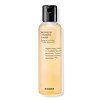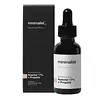What's inside
What's inside
 Key Ingredients
Key Ingredients

 Benefits
Benefits

 Ingredients Side-by-side
Ingredients Side-by-side

Propolis Extract
Skin ConditioningHoney Extract
HumectantButylene Glycol
Humectant1,2-Hexanediol
Skin ConditioningGlycerin
HumectantBetaine
HumectantCassia Obtusifolia Seed Extract
Skin ConditioningPanthenol
Skin ConditioningPolyglyceryl-10 Laurate
Skin ConditioningPolyglyceryl-10 Myristate
Skin ConditioningEthylhexylglycerin
Skin ConditioningSodium Hyaluronate
HumectantHydroxyethyl Acrylate/Sodium Acryloyldimethyl Taurate Copolymer
Emulsion StabilisingCaprylic/Capric Triglyceride
MaskingPropolis Extract, Honey Extract, Butylene Glycol, 1,2-Hexanediol, Glycerin, Betaine, Cassia Obtusifolia Seed Extract, Panthenol, Polyglyceryl-10 Laurate, Polyglyceryl-10 Myristate, Ethylhexylglycerin, Sodium Hyaluronate, Hydroxyethyl Acrylate/Sodium Acryloyldimethyl Taurate Copolymer, Caprylic/Capric Triglyceride
Water
Skin ConditioningPotassium Azeloyl Diglycinate
Skin ConditioningPropanediol
SolventGlycerin
HumectantPropolis Extract
Skin ConditioningPseudoalteromonas Ferment Extract
HumectantXylitylglucoside
HumectantAnhydroxylitol
HumectantXylitol
HumectantDimethyl Isosorbide
SolventDipotassium Glycyrrhizate
HumectantGallic Acid
AntioxidantSodium Hyaluronate
HumectantHydroxyethylcellulose
Emulsion StabilisingXanthan Gum
EmulsifyingLecithin
EmollientPhenoxyethanol
PreservativeEthylhexylglycerin
Skin ConditioningSclerotium Gum
Emulsion StabilisingPullulan
Trisodium Ethylenediamine Disuccinate
Lactic Acid
BufferingWater, Potassium Azeloyl Diglycinate, Propanediol, Glycerin, Propolis Extract, Pseudoalteromonas Ferment Extract, Xylitylglucoside, Anhydroxylitol, Xylitol, Dimethyl Isosorbide, Dipotassium Glycyrrhizate, Gallic Acid, Sodium Hyaluronate, Hydroxyethylcellulose, Xanthan Gum, Lecithin, Phenoxyethanol, Ethylhexylglycerin, Sclerotium Gum, Pullulan, Trisodium Ethylenediamine Disuccinate, Lactic Acid
 Reviews
Reviews

Ingredients Explained
These ingredients are found in both products.
Ingredients higher up in an ingredient list are typically present in a larger amount.
Ethylhexylglycerin (we can't pronounce this either) is commonly used as a preservative and skin softener. It is derived from glyceryl.
You might see Ethylhexylglycerin often paired with other preservatives such as phenoxyethanol. Ethylhexylglycerin has been found to increase the effectiveness of these other preservatives.
Glycerin is already naturally found in your skin. It helps moisturize and protect your skin.
A study from 2016 found glycerin to be more effective as a humectant than AHAs and hyaluronic acid.
As a humectant, it helps the skin stay hydrated by pulling moisture to your skin. The low molecular weight of glycerin allows it to pull moisture into the deeper layers of your skin.
Hydrated skin improves your skin barrier; Your skin barrier helps protect against irritants and bacteria.
Glycerin has also been found to have antimicrobial and antiviral properties. Due to these properties, glycerin is often used in wound and burn treatments.
In cosmetics, glycerin is usually derived from plants such as soybean or palm. However, it can also be sourced from animals, such as tallow or animal fat.
This ingredient is organic, colorless, odorless, and non-toxic.
Glycerin is the name for this ingredient in American English. British English uses Glycerol/Glycerine.
Learn more about GlycerinPropolis Extract is also known as bee glue.
This ingredient has antimicrobial, anti-inflammatory, wound healing, and antioxidant properties.
Studies show propolis helps fight against bacteria, viruses, and fungi. This may help with reducing acne and accelerate wound healing.
The flavonoids found in propolis extract are potent antioxidants. Antioxidants may help with reducing the signs of aging.
A study from 2020 found propolis to help reverse skin damage from UV.
Fun facts: This ingredient is created by mixing beeswax, bee saliva, and parts of trees. Bees use propolis as a sealant to close any gaps in their hives.
Since it is an animal-derived product, this ingredient is not considered vegan. For vegan alternatives, check out Galactomyces Ferment Filtrate or Centella Asiatica Extract.
Learn more about Propolis ExtractSodium Hyaluronate is hyaluronic acid's salt form. It is commonly derived from the sodium salt of hyaluronic acid.
Like hyaluronic acid, it is great at holding water and acts as a humectant. This makes it a great skin hydrating ingredient.
Sodium Hyaluronate is naturally occurring in our bodies and is mostly found in eye fluid and joints.
These are some other common types of Hyaluronic Acid:
Learn more about Sodium Hyaluronate